How to organize a summer water supply in a country house: laying and arranging a water supply for irrigation
Inveterate summer residents and adherents of summer suburban life are well aware of the problems associated with the lack of water supply. But water is constantly needed by plants for irrigation, animals, owners for hygienic and culinary purposes. How do you want to just open the tap and get it in the required volume, even in summer conditions. Do you agree?
We are ready to share with you all the possible ways according to which they arrange a summer water supply in the country. Here you will find reliable information about the selection of equipment and the construction of popular types of autonomous systems.
We offer a thorough analysis of the techniques, valuable recommendations on the choice of source, laying of the onshore and underground pipelines. The basis for the information presented is normative documentation and advice from experienced professionals. The information is backed up by selection of photos and videos.
The content of the article:
Distinctive features of summer water supply
The country watering system in practice turns out to be a vague and indefinite concept. For some, this is a pair of galvanized buckets and several hours a day spent on difficult “walks” to the well and back, for others it’s a long flexible hose that constantly clings and bends, for others it’s a complicated pipe system leading from the well or pond to all corners of the garden.
We will consider the most optimal options, eliminating large physical loads during irrigation and minimizing financial costs during their construction.
Of course, a seasonal water supply system can also have additional functions, for example, supplying a garage with water to wash the car, or providing an outdoor shower. However, they are possible only when a competent project has been drawn up and there are no complaints about laying a summer water supply system, otherwise instead of convenient functionality you will get many reasons for repair.
Do not forget that the summer modification differs from the winter one in some aspects of installation and maintenance:
- for laying pipes do not need deep trenches, but enough grooves with a depth of up to 0.7-0.8 m;
- during the warm period there is no need to warm the pipeline;
- for permanent systems, it is necessary to think over the drainage system (for collapsible communications, drainage occurs spontaneously during dismantling);
- temporary collapsible pipelines are connected in series, more serious, stationary - using a collector.
The difference applies to the choice of pumping equipment. For example, to supply water to the garden from a well throughout the summer period, a submersible or surface pump is sufficient. A permanent system that operates year-round requires a powerful pumping station equipped with a water heater and storage tank.
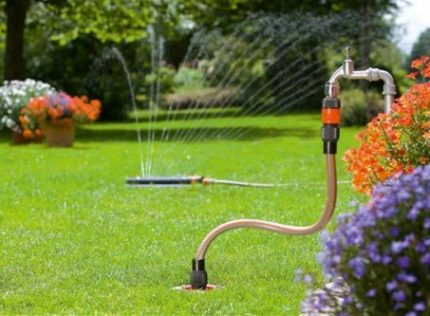
The choice of irrigation system also largely depends on the duration of the warm period. Suppose for the harsh north, where the summer lasts 3, or even 2 months, a collapsible scheme is quite enough.
And for the southern regions, where planting begins already in the early spring, it is better to build a solid, strong, reliable stationary water supply.
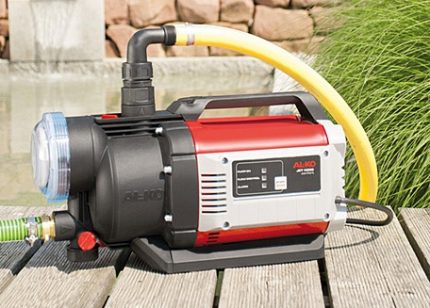
Water source selection
The productivity, length of the structure and other operational capabilities of the irrigation system largely depend on the source of water to which it will be connected.
Here is a list of options for watering:
- well or well (relevant for both new, newly developed plots, and for old, perennial possessions);
- natural water body (for example, a pond, originally located in the garden);
- centralized highway (necessary for water supply of modern cottage villages).
An excellent addition to the formation of the stock will be a storage tank for rain water, the filling of which depends on the vagaries of the weather, and the VOC storage well, in which sewage is purified, separated from the insoluble sediment.
Most often, in addition to the main source, there is a backup, for example, a large plastic tank located at a height of 1-1.5 m. If the power is suddenly turned off and the pump stops, watering is carried out from the tank.
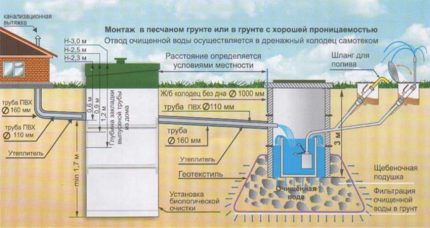
A simple, albeit costly, payment option is to connect to a central highway. The pipe leading to the irrigation point cuts into the main pipe using a tee and a ball valve without shutting off, under pressure, since the preliminary installation of the valve allows you to drill a hole through it.
Watering from a natural source requires the installation of an additional filter system, because most budget pumps work only with clean water. A filter is also necessary for equipment immersed in a well or sand well.
Cleaner water is in the artesian well, but it requires a special deep-well submersible pump (popular brands are Gileks, Grundfos, Patriot, Belamos, Caliber).

Storage tanks are different: metal and plastic, large and small, purchased and home-made. If the site is small and the tank is voluminous, there is enough fluid for several irrigation.
The pipeline, which operates in the summer, can be attached to any of these sources, but with a few caveats. Suppose a collapsible design is suitable for working with a plastic container, and it’s better to build a permanent system to connect to the well.
Types of water pipes for irrigation
Before designing a summer water supply for irrigation, you should find out which scheme is more suitable: collapsible or stationary. These two systems have the same purpose, but differ in the nuances of mounting / dismounting (collapsible) and design features.
Collapsible scheme: pros and cons
The main distinguishing feature of the collapsible design is the need for annual installation and dismantling. In spring, parts must be assembled, in autumn - disassemble, then clean all pipes, tubes, hoses and fittings, wash, dry and put in a dry room.
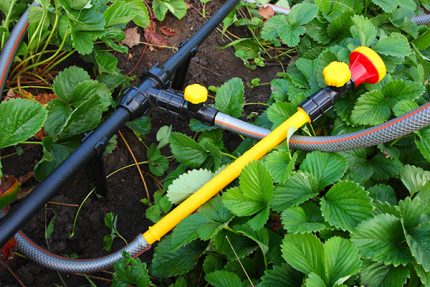
A temporary collapsible water supply system is assembled and disassembled according to the principle of a children's designer: it is necessary to take parts that are suitable in size and connect them into a structure that ensures the movement of water from the source to the irrigation site.
Simplicity of installation and budget cost made the system popular: a lot of ready-made offers from various manufacturers appeared in supermarkets.
Elements of the irrigation system are most often sold separately, but the sales assistant can select the necessary details for the finished project - from pipes and fittings to the pump. There are also full-fledged kits designed for drip irrigation, a technology quite new, but already having regular fans.
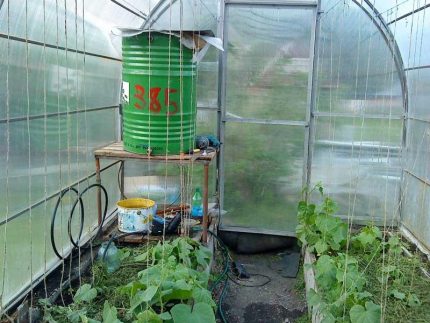
Drip irrigation occurs due to the regulated water supply through flexible hoses with small openings located near the root system of plants. The advantage is the metered supply and water saving, in which the plants receive the required amount of moisture.
The advantages of any collapsible type are:
- quick assembly and disassembly;
- assembly that does not require special knowledge;
- operational repair;
- budget cost.
There is a drawback - the need for assembly / disassembly. Many do not like finding hoses on the surface. They interfere with the movement and spoil the appearance of the site, but if you think about the neat, disguised arrangement of flexible hoses (along paths, along the edges of lawns or beds), the problem will be solved.
A photo selection will introduce the specifics of assembling an independent system of HDPE pipes:
Setting up a permanent system
For the installation of a permanent summer water supply, trenches are dug, this reminds him of communications operating throughout the year.
Unlike the winter system, pipes of the summer modification are not tied to the freezing level and therefore are located at a shallow depth of about half a meter, a maximum of 0.8 m. The depth depends on the installation location: the more actively the land is used above the pipes, the deeper they are lie.
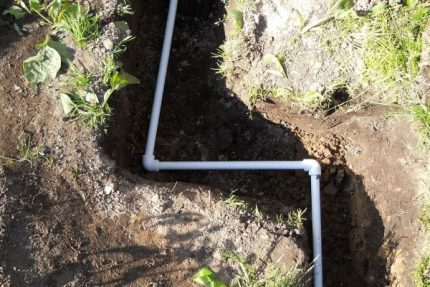
A mandatory part is a drain valve, which is necessary for the process of draining water at the end of the season. It is installed at a convenient point laid at an angle to the pipeline so that water can flow out on its own. The procedure is carried out before the onset of cold weather, without waiting for a negative temperature, otherwise the water will freeze right in the pipes and damage them.
In addition to the pipeline located underground, water-folding cranes are brought out. They are mounted at points located in close proximity to the irrigation zones - in the garden, in the garden, near flower beds and lawns, as well as in the garage.
Flexible hoses with convenient spray nozzles are attached to the taps for more efficient irrigation or spraying of plants.

The advantages of a permanent water supply:
- communications do not interfere with the movement of people and transport;
- pipes are protected by a layer of soil from damage caused by external influences;
- in spring it is not necessary to carry out installation, and at the end of the season - dismantle;
- preparation for conservation is simple - drain water from pipes.
The disadvantages are the high cost and additional excavation work. If depressurization occurs, it is not possible to quickly identify the emergency site.
The assembly of a system of rigid polymer pipes has its own characteristics:
A brief overview of materials and necessary devices
The summer water supply system consists of the following elements:
- pipes;
- cranes
- fitting;
- pump equipment;
- filters.
For comparison, during the construction of the winter, pressure control devices are required (accumulatorpressure gauge pressure switch), automatic protection, water heater.
There are many options for automated systems that allow you to regulate and control drip or greenhouse irrigation.
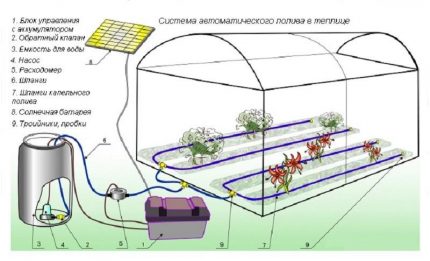
Conventional water pipes made of plastic, polypropylene or polyethylene with a diameter of 20 mm to 25 mm are more suitable for deepening into the ground. Polypropylene products with reinforced layers, for example, German Banninger pipes for hot water supply, which have a characteristic green color, are especially durable.
However, for small, low-branched schemes, white medium-strength PVC pipes are suitable.
Hoses should not be placed in the ground, but used on the surface. If you still decide to build a permanent water supply exclusively from hoses, then choose products with thick walls reinforced with nylon fibers. Their service life is usually not less than 15 years.

The only volatile element in the system is a surface or submersible pump. It should be selected based on their data on the source of water and the characteristics of the equipment itself. For example, the best option for a pond is a drainage pump, for a well - a deep pump, and for a well, a fairly inexpensive submersible model of the type "Kid" or "Trickle".
Assembly instructions for temporary water supply
For the installation of seasonal “temporary shelters”, a set of pipes and fittings that are suitable in diameter and a pump for forced water supply will be required. To correctly calculate the amount of consumables, make a drawing in the form of a sketch on which you need to specify the length of all highways and the connection.
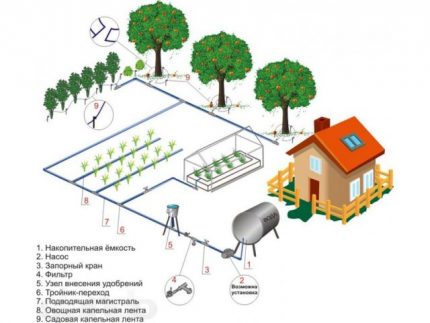
To equip drip irrigation, it is enough to purchase a ready-made kit, equipped with instructions.
To assemble according to your own scheme, proceed according to the following plan:
- lay out the pipes according to the drawing, determine the location of the water points;
- if there are enough elements, connect them with fittings;
- attach additional parts (irrigation nozzles);
- connect the system to a pre-installed pump;
- test the running water.
With the pump turned on, check the pressure at all points and the tightness of the communications. To prevent hoses and pipes from getting underfoot, try to think through a scheme so that they do not intersect the places of active traffic and the road for traffic.
If you constantly use surface water supply, use various ideas for the convenience of laying it. For example, during the construction of a garden path, lay transverse pipes with a diameter of 50-100 mm in several places under its base in several places. For the winter they can be closed with caps, and in the summer they will serve as a kind of tunnels for the installation of water pipes and hoses.
AND in this material can be read more similarly about choosing flexible watering hoses.
Installation of a stationary system with a pump
The main part of the permanent irrigation water supply system is placed in the ground, so the selection of parts and installation should be carried out with special care. We offer a universal trunking scheme suitable for simple and branched networks.
#1. Designing the landscape
Planning, taking into account all the nuances of the subsequent assembly, is half the success, so even before purchasing the necessary materials, draw up a diagram with the designation of important objects (water source, irrigation points, all buildings, paths, beds and plantings).
Using a tape measure, measure the required lengths of the section and calculate the length of the pipes and the number of connecting parts.
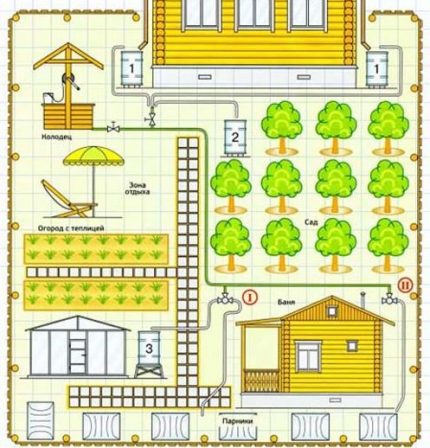
Consider how to better position the trenches relative to paths, buildings, and watering zones. Count on a shallow depth - 0.3-0.4 m, but for potentially dangerous places it needs to be increased to 0.7-0.8 m.
Do not forget about the insert of the drain tap - it is traditionally mounted near the water intake, respectively, the inclination of the pipes should also occur in the direction of the source.
The more taps, the less often the flexible hose will have to be moved. Mentally break the garden (flower garden, lawn, garden) into small areas and plan the installation of hydrants with a device for attaching a hose or a sprayer.
An approximate list of materials and tools that will be required to assemble the irrigation system:
- pipes with a set of tees, elbows and fittings;
- flexible hoses;
- cutter and soldering iron for plastic pipes (hacksaw for metal - for metal);
- ball valve ½;
- pump for installation in a well.
The availability of various parts and their quantity depends on the requirements of a particular project.
# 2 Earthwork - device of trenches
To dig a shallow trench, a single tool is required - a shovel. Buckets or a wheelbarrow for the removal of soil are not needed, since it is necessary for backfilling.
The complexity of the event depends entirely on the quality and composition of the soil and plant layer. It is easy to dig a soil with a high sand content, even with numerous plant roots, removing ORS with the inclusion of clay components is much more difficult.
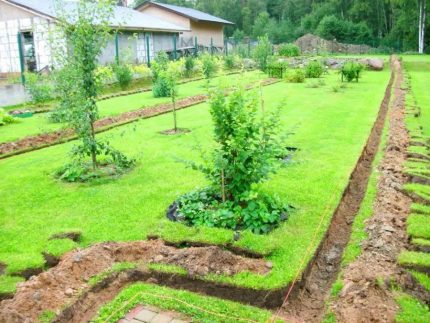
On the way to laying communications, there may be buildings that have to be circumvented around the perimeter (for example, a barn or a pool). Small cottage objects can be overcome by slightly deepening the trench. Suppose communications laid under a flowerbed at a depth of 0.7 m will not interfere with digging and caring for plants.
It should be remembered that each turn of the pipeline will reduce the efficiency of the system and increase the load on the pumping equipment. Therefore, when developing a scheme for laying a pipeline system, it is necessary to choose paths with a minimum number of turns, and preferably with their complete absence.
# 3 Pipeline Assembly Options
Previously, when metal pipes were used, it was necessary to deal with steel parts, the cutting and assembly of which was more time-consuming. Now they use plastic pipes, which are interconnected in two ways - by welding or fittings.
The first technology is a bit more complicated, but the result is more reliable. Before welding, it is necessary to prepare polypropylene pipes - cut into fragments of the required length. For the central highway, a pipe with a diameter of 20-25 mm is suitable, for branches - 10-20 mm, so cutting can be done with scissors or a roller cutter.
For welding, you need a special welding machine - soldering iron with TEN and compact control unit. As a result of heating, the pipes are soldered with fittings, forming a monolithic tight design.
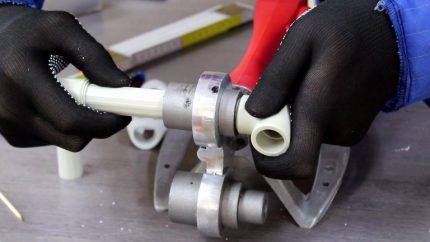
Before starting welding work, carefully read the instructions and remember the rules for using the welding machine. For example, do not cool pipes with cold water or compressed air.
Having assembled the pipe structure, you do not need to backfill - first you connect to the pumping equipment and check the operation.
#4. Pump connection and testing
As a rule, at the time of construction of the irrigation system, the pump is already installed. If not, you must select a model that is suitable for a particular source (for example, a well) and install it according to the instructions.
The submersible pump is lowered into the water and fixed at a certain distance from the bottom, the surface is installed next to the well, covering it with a protective casing.
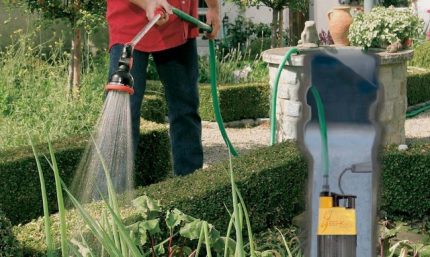
The crucial moment is testing. After connecting all the elements into a single system, turn on the pump and check the tightness of the water supply. Pay attention to the quality of irrigation - is there enough pressure at the most distant points. If everything suits you, you can backfill by slightly tamping the soil and start using the summer system.
Maintenance mainly relates to the operation of the pump. The pipeline only needs preparation for winter conservation. To do this, open the tap and drain the water.
Conclusions and useful video on the topic
Useful and informative videos to understand how the summer irrigation system looks and learn more about its installation.
Variant of arrangement of a country water supply system with connection to a well:
In the next video, we will talk about how to build a plastic water pipe yourself:
A detailed overview of the elements for an irrigation system:
As you can see, the device of a summer water supply for irrigation is affordable for any summer resident who knows how to handle a pump. If you have any questions or difficulties, we recommend that you contact specialists who are engaged in landscape design or equipping summer cottages with water supply systems.
Concerned about arranging a summer cottage? Or maybe it was already possible to independently carry out its installation and you have something to share with our readers? Please share your experience, write your comments, ask questions at the bottom of the article.

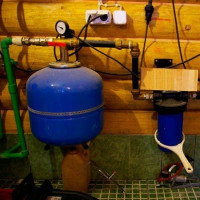 How to make a water pipe in the country with your own hands: the rules for laying, installing and arranging
How to make a water pipe in the country with your own hands: the rules for laying, installing and arranging 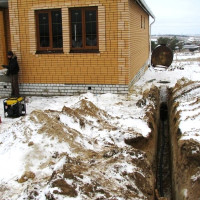 How to organize the introduction of water into the house: the choice of water supply method + arrangement options
How to organize the introduction of water into the house: the choice of water supply method + arrangement options 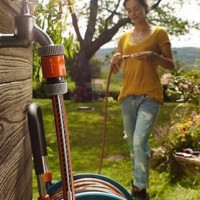 Which watering hose is better to choose: popular views + what to look at when choosing
Which watering hose is better to choose: popular views + what to look at when choosing 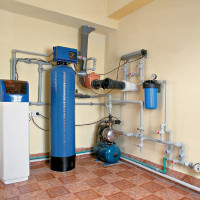 Plumbing in a private country house do-it-yourself: the rules of arrangement
Plumbing in a private country house do-it-yourself: the rules of arrangement 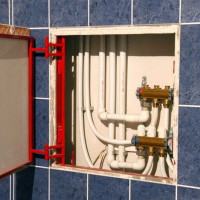 Water distribution in a private house: design rules + an overview of the best schemes
Water distribution in a private house: design rules + an overview of the best schemes 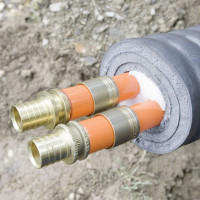 Water supply insulation in the ground: rules for thermal insulation of external branches
Water supply insulation in the ground: rules for thermal insulation of external branches  How much does it cost to connect gas to a private house: the price of organizing gas supply
How much does it cost to connect gas to a private house: the price of organizing gas supply  The best washing machines with dryer: model rating and customer tips
The best washing machines with dryer: model rating and customer tips  What is the color temperature of light and the nuances of choosing the temperature of the lamps to suit your needs
What is the color temperature of light and the nuances of choosing the temperature of the lamps to suit your needs  Replacement of a geyser in an apartment: replacement paperwork + basic norms and requirements
Replacement of a geyser in an apartment: replacement paperwork + basic norms and requirements
I never thought that in such a straightforward way you can make a convenient water supply in your own area. Of course, it will be necessary to work, dig trenches, purchase all the necessary elements (pipes, taps, fittings). I think it's worth it. Interestingly, the water for the plants should not be completely cold. Desirable defended. How to properly equip the wells and the summer water supply itself, so that the water has time to heat up?
The material presents a scheme of irrigation from a barrel / storage tank. This is enough so that the water is not ice, and more is not needed.
Hello! According to the recommendations of agricultural technicians, it is advisable to specially heat water for irrigation of agricultural crops in the following cases:
- water gets to plants directly from underground source (your case);
- watering is carried out by sprinkling or drip irrigation;
- air temperature above +33 C.
Basically, there are two ways to heat well water:
1) Use of intermediate tanks (this option is described in the article).
2) Insert pipe for irrigation immediately after the water heater. When opening the tap, water from the well will mix with hot. In this case, it is important to organize the pressure difference so that it is hot that enters the cold, and not vice versa.
And I did drip irrigation in my summer cottage. I had to tinker with it while I mounted an extensive network of flexible hoses throughout the territory, while I patched it in the ground. But the whole summer there were no problems with watering. True, the wife managed in several places to damage the hoses with a hoe. I fixed the damage. In the autumn, too, it is necessary to dismantle all this, put it away for storage. High-quality watering is worth all this trouble. Liked it.